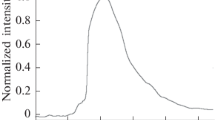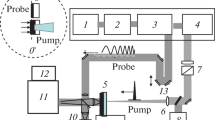Abstract
An interferometric method is used in the picosecond range to study the evolution of shock-compression waves generated in metallic film specimens by a powerful femtosecond laser. Shock waves with compression stress behind the elastic precursor front up to 27.5 GPa and 12.6 GPa, respectively, were registered in the case of submicron propagation length in iron and aluminum. The obtained values of the shear and bulk strength are comparable with computed values of the theoretical ultimate shear and tensile strength.
Similar content being viewed by others
References
S. I. Ashitkov, M. B. Agranat, G. I. Kanel, et al., “Behavior of Aluminum near an Ultimate Theoretical Strength in Experiments with Femtosecond Laser Pulses,” Pis’ma Zh. Eksp. Teor. Fiz. 92(8), 568–573 (2010) [JETP Lett. (Engl. Transl.) 92 (8), 516–520 (2010)].
V. H. Whitley, S. D. MaGrane, D. E. Eakins, et al., “The Elastic-Plastic Response of Aluminum Films to Ultrafast Laser-Generated Shocks,” Appl. Phys. 109, 013505 (2011).
J. C. Crowhurst, M. R. Armstrong, K. B. Knight, et al., “Invariance of the Dissipative Action at Ultrahigh Strain Rates above the Strong Shock Threshold,” Phys. Rev. Lett. 107, 144302 (2011).
S. I. Ashitkov, M. B. Agranat, G. I. Kanel, and V. E. Fortov, “Approaching the Ultimate Shear and Tensile Strength of Aluminum in Experiments with Femtosecond Pulse Laser,” in 17th Topical Conference on Shock Compression of Condensed Matter, Chicago, USA, June 26–July 1, 2011, Vol. 1426 (AIP Conf. Proc., 2012), pp. 1082–1084.
S. I. Ashitkov, P. S. Komarov, M. B. Agranat, et al., “Achievement of Ultimate Values of the Bulk and Shear Strengths of Iron Irradiated by Femtosecond Laser Pulses,” Pis’ma Zh. Eksp. Teor. Fiz. 98(7), 439–444 (2013) [JETP Lett. (Engl. Transl.) 98 (7), 384–388 (2013)].
K. Kadau, T. C. Germann, P. S. Lomdahl, and B. L. Holian, “Atomistic Simulations of Shock-Induced Transformations and Their Orientation Dependence in BCC Fe Single Crystals,” Phys. Rev. B 72, 064120 (2005).
B. J. Demaske, V. V. Zhakhovsky, N. A. Inogamov, and I. I. Oleynik, “Ultrashort Shock Waves in Nickel Induced by Femtosecond Laser Pulses,” Phys. Rev. B 87, 054109 (2013).
J. C. Crowhurst, B.W. Reed, M. R. Armstrong, et al., “The α→ɛ Phase Transition in Iron at Strain rates up to ∼ 109 s−1,” J. Appl. Phys. 115, 113506 (2014).
V. P. Skripov, Metastable Fluid (Nauka, Moscow, 1972) [in Russian].
M. Jahnátek, J. Hafner, and M. Krajčí, “Shear Deformation, Ideal Strength, and Staking Fault Formation of FCC Metals: A Density Functional Study of Al and Cu,” Phys. Rev. B 79, 224103 (2009).
D. M. Clutterbuck, C. R. Krenn, M. L. Cohen, and J. W. Morris Jr., “Phonon Instabilities and the Ideal Strength of Aluminum,” Phys. Rev. Lett. 91, 135501 (2003).
G. Kimminau, P. Erhart, E. M. Bringa, et al., “Phonon Instabilities in Uniaxially Compressed FCC Metals as Seen in Molecular Dynamics Simulations,” Phys. Rev. B 81, 092102 (2010).
C. A. Bolme, S. D. MaGrane, D. S. Moore, and D. J. Funk, “Single Shot Measurements of Laser Driven Shock Wave Using Ultrafast Dynamic Ellipsometry,” J. Appl. Phys. 102, 033513 (2007).
D. S. Moore, K. T. Gahagan, J.H. Reho, et al., “Ultrafast Nonlinear Optical Method for Generation of Planar Shocks,” Appl. Phys. Lett. 78, 40 (2001).
K. T. Gahagan, D. S. Moore, D. J. Funk, et al., “Ultrafast Interferometric Microscopy for Laser-Driven Shock Wave Characterization,” J. Appl. Phys. 92, 3679 (2002).
S. I. Anisimov, N. A. Inogamov, Y. V. Petrov, et al., “Thresholds for Front-Side Ablation and Rear-Side Spallation of Metal Foil Irradiated by Femtosecond Laser Pulse,” Appl. Phys. A 92, 797 (2008).
V. V. Temnov, K. Sokolovski-Tinten, P. Zhou, and D. von der Linde, “Ultrafast Imaging Interferometry at Femtosecond-Laser-Excited Surfaces,” J. Opt. Soc. Am. B 23, 1954 (2006).
S. I. Ashitkov, P. S. Komarov, A. V. Ovchinnikov, et al., “Deformation Dynamics and Spallation Strength of Aluminium under a Single-Pulse Action of a Femtosecond Laser,” Kvant. Elektron. 43(3), 242–245 (2013) [Quantum Electron. (Engl. Transl.) 43 (3), 242–245 (2013)].
L.M. Barker and R. E. Hollenbach, “Shock Wave Study of Phase Transition in Iron,” J. Appl. Phys. 45, 4872 (1974).
Ya. B. Zel’dovich and Yu. P. Raizer, Physics of Shock Waves and High Temperature Hydrodynamical Phenomena (Nauka, Moscow, 1966) [in Russian].
G. I. Kanel, S. V. Razorenov, and V. E. Fortov, Shock-Wave Phenomena and the Properties of Condensed Matter (Springer, New York, 2004).
R. F. Smith, J. H. Eggert, R. E. Rudd, et al., “High Strain-Rate Plastic Flow in Al and Fe,” J. Appl. Phys. 110, 123515 (2011).
G. I. Kanel, S. V. Razorenov, and V. E. Fortov, “Submicrosecond Strength of Materials,” Mech. Solids 40(4), 69 (2005).
G. I. Kanel, S. V. Razorenov, G. V. Garkushin, et al., “Deformation Resistance and Fracture of Iron over a Wide Strain Rate Range,” Fiz. Tverd. Tela 56(8), 1518–1522 (2014) [Phys. Solid State (Engl. Transl.) 56 (8), 1569–1573 (2014)].
G. I. Kanel, “Dynamic Strength of Materials,” Fatig. Fract. Engng Mater. Struct. 22(11), 1011 (1999).
P. A. Zhilyaev, A. Yu. Kuksin, V. V. Stegailob, and A. V. Yanilkin, “Influence of Plastic Deformation on Fracture of an Aluminum Single Crystal under Shock-Wave Loading,” Fiz. Tverd. Tela 52(8), 1508–1512 (2010) [Phys. Solid State (Engl. Transl.) 52 (8), 1619–1624 (2010)].
V. V. Zhakhovskii, N. A. Inogatov, Yu. V. Petrov, et al., “Molecular Dynamics Simulation of Femtosecond Ablation and Spallation with Different Interatomic Potentials,” Appl. Surf. Sci. 255, 9592 (2009).
D. M. Clattenbuck, D. C. Chrzan, and J.W. Morris, “The Ideal Strength of Iron in Tension and Shear,” Acta Mater. 51, 2271 (2003).
S. Ogata, J. Li, N. Hirosaki, et al., “Ideal Shear Strain of Metals and Ceramics,” Phys. Rev. B 70, 104104 (2004).
M. Cerny and J. Pokluda, “Influence of Superimposed Biaxial Stress on the Tensile Strength of Perfect Crystals from first Principles,” Phys. Rev. B 76, 024115 (2007).
Author information
Authors and Affiliations
Corresponding author
Additional information
Original Russian Text © M.B. Agranat, S.I. Ashitkov, P.S. Komarov, 2014, published in Izvestiya Akademii Nauk. Mekhanika Tverdogo Tela, 2014, No. 6, pp. 50–57.
About this article
Cite this article
Agranat, M.B., Ashitkov, S.I. & Komarov, P.S. Metal behavior near theoretical ultimate strength in experiments with femtosecond laser pulses. Mech. Solids 49, 643–648 (2014). https://doi.org/10.3103/S0025654414060053
Received:
Published:
Issue Date:
DOI: https://doi.org/10.3103/S0025654414060053




